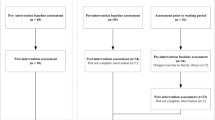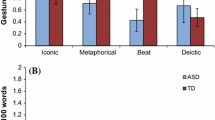Abstract
In this study, we videotaped two 10-min. free-play interactions and coded speech acts (SAs) in peer talk of 51 preschoolers (21 ASD, 30 typical), interacting with friend versus non-friend partners. Groups were matched for maternal education, IQ (verbal/nonverbal), and CA. We compared SAs by group (ASD/typical), by partner’s friendship status (friend/non-friend), and by partner’s disability status. Main results yielded a higher amount and diversity of SAs in the typical than the ASD group (mainly in assertive acts, organizational devices, object-dubbing, and pretend-play); yet, those categories, among others, showed better performance with friends versus non-friends. Overall, a more nuanced perception of the pragmatic deficit in ASD should be adopted, highlighting friendship as an important context for children’s development of SAs.
Similar content being viewed by others
References
Adams, C. (2002). Practitioner review: The assessment of language pragmatics. Journal of Child Psychology and Psychiatry, 43, 973–987.
Adams, C., Green, J., Gilchrist, A., & Cox, A. (2002). Conversational behaviour of children with Asperger syndrome and conduct disorder. Journal of Child Psychology and Psychiatry, 43, 679–690.
American Psychiatric Association (2000). Diagnostic and statistical manual of mental disorders, fourth edition: DSM-IV-TR. Washington, DC: Author.
American Psychiatric Association (2013). Diagnostic and statistical manual of mental disorders: Text revision (5th edn.). Washington, DC: Author.
Bauminger, N., Solomon, N., Aviezer, A., Heung, K., Brown, J., & Rogers, S. J. (2008). Friendship in high-functioning children with autism spectrum disorder: Mixed and non-mixed dyads. Journal of Autism and Developmental Disorders, 38, 1211–1229.
Bauminger-Zviely, N., & Agam-Ben-Artzi, G. (2014). Young friendship in HFASD and typical development: friend versus non- friend comparisons. Journal of Autism Development Disorder, 44, 1733–1748.
Bauminger-Zviely, N., Karin, E., Kimhi, Y., & Agam-Ben-Artzi, G. (2014). Spontaneous peer conversation in preschoolers with high-functioning autism spectrum disorder versus typical development. Journal of Child Psychology and Psychiatry, 55, 363–373.
Bone, D., Lee, C., Chaspari, T., Black, M. P., Williams, M. E., Lee, S., Levitt, P., & Narayanan, S. (2013). Acoustic-prosodic, turn-taking, and language cues in child-psychologist interactions for varying social demand. INTERSPEECH, 2400–2404.
Brachfeld-Child, S., & Schiavo, R. S. (1990). Interactions of preschool and kindergarten friends and acquaintances. Journal of Genetic Psychology: Research and Theory on Human Development, 151(1), 45–58.
Capps, L., Kehres, J., & Sigman, M. (1998). Conversational abilities among children with autism and children with developmental delays. Autism: The International Journal of Research and Practice, 2, 325–344.
Dore, J. (1979). Conversational acts and the acquisition of language. In E. Ochs & B. B. Schieffelin (Eds.), Developmental pragmatics (pp. 339–361). New York: Academic Press.
Dore, J. (1986). The development of conversational competence. In R. L. Schiefelbusch (Ed.), Language competence assessment and intervention (pp. 3–60). San Diego: University of Kansas College Hill Press.
Dunn, J., & Cutting, A. L. (1999). Understanding others, and individual differences in friendship interactions in young children. Social Development, 8(2), 201–219.
Dunn, J., Cutting, A. L., & Fisher, N. (2002). Old friends, new friends: Predictors of children’s perspectives on their friends at school. Child Development, 73, 621–636.
Eigsti, I. M., De Marchena, A. B., Schuh, J. M., & Kelley, E. (2011). Language acquisition in autism spectrum disorder: a developmental review. Research in Autism Spectrum Disorders, 5, 681–691.
Hermelin, B., & O’Connor, N. (1985). The logico-affective disorder in autism. In E. Schopler & G. B. Mesibov (Eds.), Communication problems in autism (pp.<background-color:#96C864;> </background-color:#96C864;>283–310). New York: Plenum Press.
Howes, C. (1996). The earliest friendships. In W. M. Bukowski, A. F. Newcomb & W. W. Hartup (Eds.), The company they keep: Friendship in childhood and adolescence (pp. 66–86). Cambridge: Cambridge University Press.
Jarrold, C. (2003). A review of research into pretend play in autism. Autism: The International Journal of Research and Practice, 7(4), 379–390.
Jones, C. D., & Schwartz, I. S. (2009). When asking questions is not enough: An observational study of social communication differences in high functioning children with autism. Journal of Autism and Developmental Disorders, 39, 432–443.
Jordan, R. (2003). Social play and autistic spectrum disorders: A perspective on theory, implications and educational approaches. Autism: The International Journal of Research and Practice, 7, 347–360.
Kasari, C., Locke, J., Gulsrud, A., & Rotheram-Fuller, E. (2011). Social networks and friendships at school: Comparing children with and without ASD. Journal of Autism and Developmental Disorders, 41(5), 533–544.
Kasari, C., & Ya-Chin, C. (2013). Play development in children with autism spectrum disorders: Skills, object play, and intervention. In F. R. Volkmar, S. J. Rogers, R. Paul, & & K. A. Pelphery (Eds.), Handbook of autism and developmental disorders, 4th edition (pp. 230–262). Hoboken, NJ: Wiley.
Kissine, M., Cano-Chervel, J., Carlier, S., De Brabanter, P., Ducenne, L., Pairon, M.C., Deconinck, N., Delvenne, V., & Leybaert, J. (2015). Children with autism understand indirect speech acts: Evidence from a semi-structured act-out task. PLoS ONE, 10(11), Article e0142191.
Kjellmer, L., Hedvall, Å., Fernell, E., Gillberg, C., & Norrelgen, F. (2012). Language and communication skills in preschool children with autism spectrum disorders: Contribution of cognition, severity of autism symptoms, and adaptive functioning to the variability. Research in Developmental Disabilities, 33, 172–180.
Leekam, S. R., Prior, M. R., & Uljarevic, M. (2011). Restricted and repetitive behaviors in autism spectrum disorders: A review of research in the last decade. Psychological Bulletin, 137, 562–593.
Lord, C., & Magill-Evans, J. (1995). Peer interactions of autistic children and adolescents. Development and Psychopathology, 7(4), 611–626.
Miller-Wetherby, A., & Prutting, C. A. (1984). Profiles of communicative and cognitive-social abilities in autistic children. Journal of Speech and Hearing Research, 27, 364–377.
Mullen, E. M. (1995). Mullen scales of early learning. Los Angeles: Western Psychological Service.
Newcomb, A. F., & Bagwell, C. L. (1995). Children’s friendship relations: A meta analytic review. Psychological Bulletin, 117(2), 306–347.
Paparella, T., Goods, K. S., Freeman, S., & Kasari, C. (2011). The emergence of joint attention and requesting skills in young children with autism. Journal of Communication Disorders, 44, 569–583.
Pennebaker, J. W., Francis, M. E., & Booth, R. J. (2001). Linguistic inquiry and word count: LIWC 2001. Mahwah, NJ: Erlbaum.
Plumet, M. H., & Veneziano, E. (2015). Typical and atypical pragmatic functioning of ASD children and their partners: A study of oppositional episodes in everyday interactions. Journal of Autism and Developmental Disorders, 45(1), 53–67.
Rutter, M., Le Couteur, A., & Lord, C. (2003). The autism diagnostic interview—Revised (ADI-R) manual. Los Angeles: Western Psychological Services.
Ryckebusch, C., & Marcos, H. (2004). Speech acts, social context and parent toddler play between the ages of 1:5 and 2:3. Journal of Pragmatics, 36, 883–897.
Sigman, M., & Ruskin, E. (1999). Continuity and change in the social competence of children with autism, Down syndrome, and developmental delays. Monographs of the Society for Research in Child Development, 64(1), v-114.
Snow, C. E., Pan, B. A., Imbens-Bailey, A., & Herman, J. (1996). Learning how to say what one means: A longitudinal study of children’s speech act use. Social Development, 5, 56–84.
Stefanatos, G. A., & Baron, I. S. (2011). The ontogenesis of language impairment in autism: A neuropsychological perspective. Neuropsychology Review, 21, 252–270.
Stone, W. L., & Caro-Martinez, L. M. (1990). Naturalistic observations of spontaneous communication in autistic children. Journal of Autism and Developmental Disorders, 20(4), 437–453.
Ziatas, K., Durkin, K., & Pratt, C. (2003). Differences in assertive speech acts produced by children with autism, Asperger syndrome, specific language impairment, and normal development. Development and Psychopathology, 15, 73–94.
Acknowledgments
This research was partially supported by the Israel Science Foundation given to the first author. Special thanks are extended to the children who took part in this study. The authors would like to express their appreciation to Dee B. Ankonina for her editorial contribution and to Dov Har–Even for his statistical assistance.
Funding
This research was partially supported by the Israel Science Foundation (ISF/ No.502/06) to the first author, Nirit Bauminger-Zviley.
Author information
Authors and Affiliations
Corresponding author
Ethics declarations
Conflict of interest
All authors declare that they have no conflict of interest.
Ethical approval
All procedures performed in studies involving human participants were in accordance with the ethical standards of the national research committee and with the 1964 Helsinki declaration and its later amendments or comparable ethical standards.
Informed consent
Informed consent was obtained from all individual participants included in the study.
Appendix
Appendix
Dore’s (1979) Taxonomy Subcategories: Description and Examples of Assertives, Requestives, and Responsives
Assertives
Declarations These utterances create social facts, such as:procedurals for invoking norms or rules, setting procedures, or defining conditions (“This is not the right way to build a pyramid,” “This is the sea and here are the bears”); claims for the speaker’s rights (“I’m first,” “My turn now”); the use of jokes (“We throw soup on the roof”), teasing (“You can’t catch me”), and warnings (“Pay attention,” “Be careful”).
Evaluations These utterances judge situations/conditions, such as:evaluatives that express personal judgment or attitudes (“These are ugly things,” “This is fun”); attributions that express beliefs about another’s state (“He wants to go,” “He loves her”); and explanations that express casual relations, give reasons, or make predictions (“He’s crying because he got hit,” “I did it because it was fun”).
Reports These utterances represent existing states, such as:identifications that label objects and/or events (e.g., “This is a car”); descriptions (“It fell,” “It’s the same”); sharings that describe events referring personally to the speaker, beyond the “here and now” (“My friend Orr had grape juice in his old house”); and internal reports of mental states and emotions (“I like it,” “That hurts”).
Requestives
Questions These utterances include:choice questions (Yes or no?); product WH questions (Who? Which? Where? When? What?); and process questions that seek explanation or extend description (Why? How? What for? What about? How come?).
Requests These utterances include actions (“Sit,” “Give me”); permissions (“Can I take this?”); and action suggestions (“Let’s do this”).
Responsives
Answers These utterances provide answers to choice (“Yes;” “No”), product (“He’s here”), and process (“I wanted to”) questions, as well as compliances (“Okay”) and clarifications that are not necessarily in reply to questions (“I said no,” “Really,” “Just kidding”).
Unsolicited replies These replies to non-soliciting utterances include:descriptions of qualifications (“But I can’t do it”); agreements (“Exactly”) or rejections (“Not true”); and acknowledgments (“Aha”).
Rights and permissions
About this article
Cite this article
Bauminger-Zviely, N., Golan-Itshaky, A. & Tubul-Lavy, G. Speech Acts During Friends’ and Non-friends’ Spontaneous Conversations in Preschool Dyads with High-Functioning Autism Spectrum Disorder versus Typical Development. J Autism Dev Disord 47, 1380–1390 (2017). https://doi.org/10.1007/s10803-017-3064-x
Published:
Issue Date:
DOI: https://doi.org/10.1007/s10803-017-3064-x




